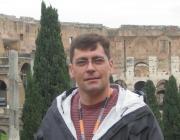Background.
My current research program focuses on the prehistoric Casas Grandes Culture located in what is now northern Chihuahua, Mexico. A regional system developed during the Medio Period (1250-1450 C.E.) centred on the large ritual and economic centre of Paquimé on the Rio Casas Grandes. Paquimé and its associated Medio Period regional system has been extensively studied by archaeologists because its exotic trade goods, impressive pueblo-style architecture, polychrome ceramics, ballcourts and platform mounds seem to make it the most Mesoamerican-like archaeological culture within the Greater American Southwest. The period immediately prior to the emergence of Paquimé, however, has remained comparably unknown, leading to some wildly divergent interpretations about the origins of the social and political complexity that appear in the 14th Century.

Paquimé (wikimedia commons)
In 2005, I joined the Proyecto Arqueológico Chihuahua (PAC) as a collaborator in a project that aimed to study the Viejo Period (800-1250 C.E.), which immediately precedes Paquimé's emergence. For the past 20 years, PAC has been directed by Prof. Jane Kelley at the University of Calgary and has located and excavated Casas Grandes sites in the Santa Maria, Babicora and Laguna Bustillos Valley. As part of the PAC project, I conducted some of the first intensive surveys of the Santa Clara Valley, which has the most southeasterly expressions of Casas Grandes Culture. The surveys identified over 50 new sites spanning the entire cultural sequence. Most surprisingly, we identified was an impressive Medio period regional centre with a ballcourt and possible platform mound (Ch-315).
Proyecto Arqueológico Santa Clara.
In the final year of the PAC project, I began the Proyecto Arqueológico Santa Clara (PASC) to investigate the ballcourt and its neighbouring sites. The first PASC field studies used Ground Penetrating Radar (GPR) to explore three of the largest Medio period sites in the valley. The surveys identified Viejo pithouse structures beneath all of them, including what may be a relatively large pithouse village adjacent to the ballcourt at Ch-315. These findings are particularly exciting because they indicate that settlements in the Santa Clara Valley were likely occupied continuously throughout the Viejo and Medio periods. As a result, we have a relatively unique opportunity to trace the emergence of the Casas Grandes Regional System outside of Paquimé's core area.

Ch-315 GPR
In 2012, PASC assembled students from the University of Lethbridge and Universidad Autónoma de San Luis Portosí to excavate a pithouse at the site of Ch-240. The house, which dates to the late 11th Century, is associated with a square storeroom and both structures were burned with most of their contents intact. We are currently completing the analysis, but it appears that the site will shed important light on the transition from the Viejo to Medio period.

Upcoming research in the Santa Clara will focus on documenting how the ritual architecture at Ch-315 relates temporally to Paquimé’s florescence further north. Medio period sites in the valley seem to reflect what Mike Whalen and Paul Minnis have described as a settlement cluster. The project has received seed funding to reassess PAC site data using a Geographic Information System. In 2014, the project will conduct test excavations at Ch-315 and radiocarbon date Medio period features at the site.
The long term research objectives for the Proyecto Arqueológico Santa Clara are to look at how households became integrated into larger social systems both within the valley and within Paquimé's wider sphere of influence. The presence of several multicomponent Viejo/Medio sites means that the valley has near perfect conditions to assess alternative hypotheses for the emergence of social complexity in the Medio period other than in Paquimé's core area. The outstanding success of our GPR surveys will allow us to select specific subsurface features for excavation and analysis.
Graduate Research Opportunities.
The project is actively seeking graduate students who may be interested in using the Santa Clara materials as a basis for their thesis at the University of Lethbridge or at other universities.


